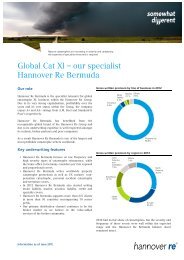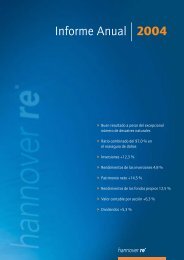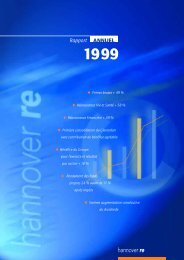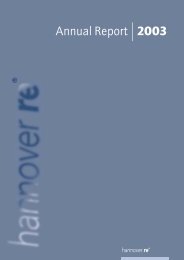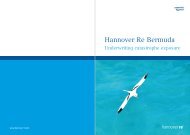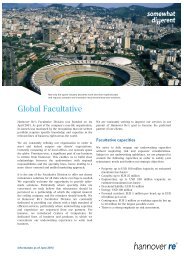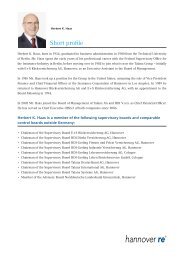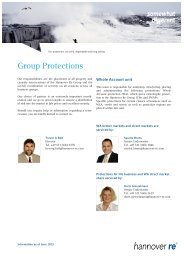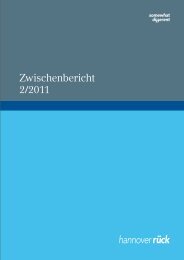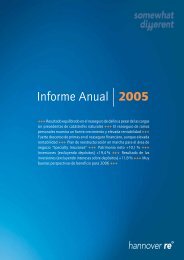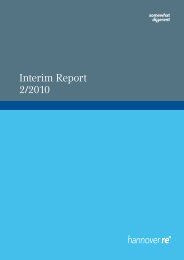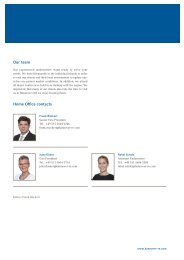Annual Report 2010 - Hannover Re
Annual Report 2010 - Hannover Re
Annual Report 2010 - Hannover Re
You also want an ePaper? Increase the reach of your titles
YUMPU automatically turns print PDFs into web optimized ePapers that Google loves.
We use derivative financial instruments to a very limited extent.<br />
The primary purpose of such financial instruments is to<br />
hedge against potentially adverse situations on capital markets.<br />
In the year under review we took out inflation swaps to<br />
hedge part of the inflation risks associated with the loss reserves<br />
in our technical account. In addition, as in the previous<br />
year, a modest portion of our cash flows from the insurance<br />
business was hedged using forward exchange transactions.<br />
The contracts are concluded solely with first-class counterparties<br />
and exposures are controlled in accordance with the restrictive<br />
parameters set out in the investment guidelines so as<br />
to avoid risks – especially credit risks – associated with the use<br />
of such transactions.<br />
Credit risks<br />
The credit risk consists primarily of the risk of complete or<br />
partial failure of the counterparty and the associated default<br />
on payment. Also significant here is the so-called migration<br />
risk, which results from a deterioration in the counterparty<br />
credit quality and is reflected in a change in fair value. Since<br />
the business that we accept is not always fully retained, but<br />
instead portions are retroceded as necessary, the credit risk is<br />
also material for our company in non-life reinsurance. Our<br />
retrocession partners are carefully selected and monitored in<br />
light of credit considerations in order to keep the risk as small<br />
as possible. This is also true of our broker relationships, under<br />
which risks may occur inter alia through the loss of the premium<br />
paid by the cedant to the broker or through double payments<br />
of claims. We minimise these risks, inter alia, by reviewing<br />
all broker relationships once a year with an eye to<br />
criteria such as the existence of professional indemnity insurance,<br />
payment performance and proper contract implementation.<br />
A Security Committee continuously monitors the credit<br />
status of retrocessionaires and approves measures where necessary<br />
to secure receivables that appear to be at risk of default.<br />
This process is supported by our “Cession Limits” Webbased<br />
risk management application, which specifies cession<br />
limits for the individual retrocessionaires participating in protection<br />
cover programmes and determines the capacities still<br />
available for short-, medium- and long-term business (cession<br />
management). Depending on the type and expected run-off<br />
duration of the reinsured business, the selection of reinsurers<br />
takes into account not only the minimum ratings of the rating<br />
agencies Standard & Poor’s and A. M. Best but also internal<br />
and external expert assessments (e.g. market information<br />
from brokers). Overall, retrocessions conserve our capital,<br />
stabilise and optimise our results and enable us to act on opportunities<br />
without restriction, e.g. following a catastrophe<br />
loss event. <strong>Re</strong>gular visits to our retrocessionaires give us a<br />
reliable overview of the market and put us in a position to<br />
respond quickly to capacity changes. Through these close<br />
contacts with our retrocessionaires we are consistently able to<br />
provide a stable renewals forecast. The determination of our<br />
gross capacity is based on this forecast. Our assumptions are<br />
continuously updated during each renewal phase and also<br />
include a built-in safety margin. Not only that, additional<br />
capacities are kept available for potential defaults – although<br />
they are not normally required. The table on the following<br />
page shows how the proportion of assumed risks that we do<br />
not retrocede (i.e. that we run in our retention) has changed<br />
in recent years.<br />
Alongside traditional retrocessions in non-life reinsurance we<br />
also transfer risks to the capital market. Yet credit risks are<br />
relevant to our investments and in life and health reinsurance,<br />
too, because we prefinance acquisition costs for our ceding<br />
companies. Our clients, retrocessionaires and broker relationships<br />
as well as our investments are therefore carefully evaluated<br />
and limited in light of credit considerations and are constantly<br />
monitored and controlled within the scope of our<br />
system of limits and thresholds.<br />
The key ratios for management of our bad debt risk are as<br />
follows:<br />
• 92.4% of our retrocessionaires have an investment grade<br />
rating (“AAA” to “BBB”),<br />
• 91.8% are rated “A” or better.<br />
• Since 2006 we have reduced the level of recoverables by<br />
altogether 66%.<br />
• 31.7% of our recoverables from reinsurance business are<br />
secured by deposits or letters of credit. What is more, for the<br />
majority of our retrocessionaires we also function as reinsurer,<br />
meaning that in principle recoverables can potentially<br />
be set off against our own liabilities.<br />
• In terms of the <strong>Hannover</strong> <strong>Re</strong> Group’s major companies, EUR<br />
246.7 million (8.7%) of our accounts receivable from reinsurance<br />
business totalling EUR 2,841.3 million were older<br />
than 90 days as at the balance sheet date.<br />
• The average default rate over the past three years was 0.1%.<br />
<strong>Re</strong>trocession gives rise to claims that we hold against our retrocessionaires.<br />
These reinsurance recoverables – i.e. the reinsurance<br />
recoverables on unpaid claims – amounted to EUR<br />
1,025.3 million (EUR 1,748.0 million) as at the balance sheet<br />
date.<br />
66 Management report opportunity and risk report<br />
<strong>Hannover</strong> <strong>Re</strong> Group annual report <strong>2010</strong>



